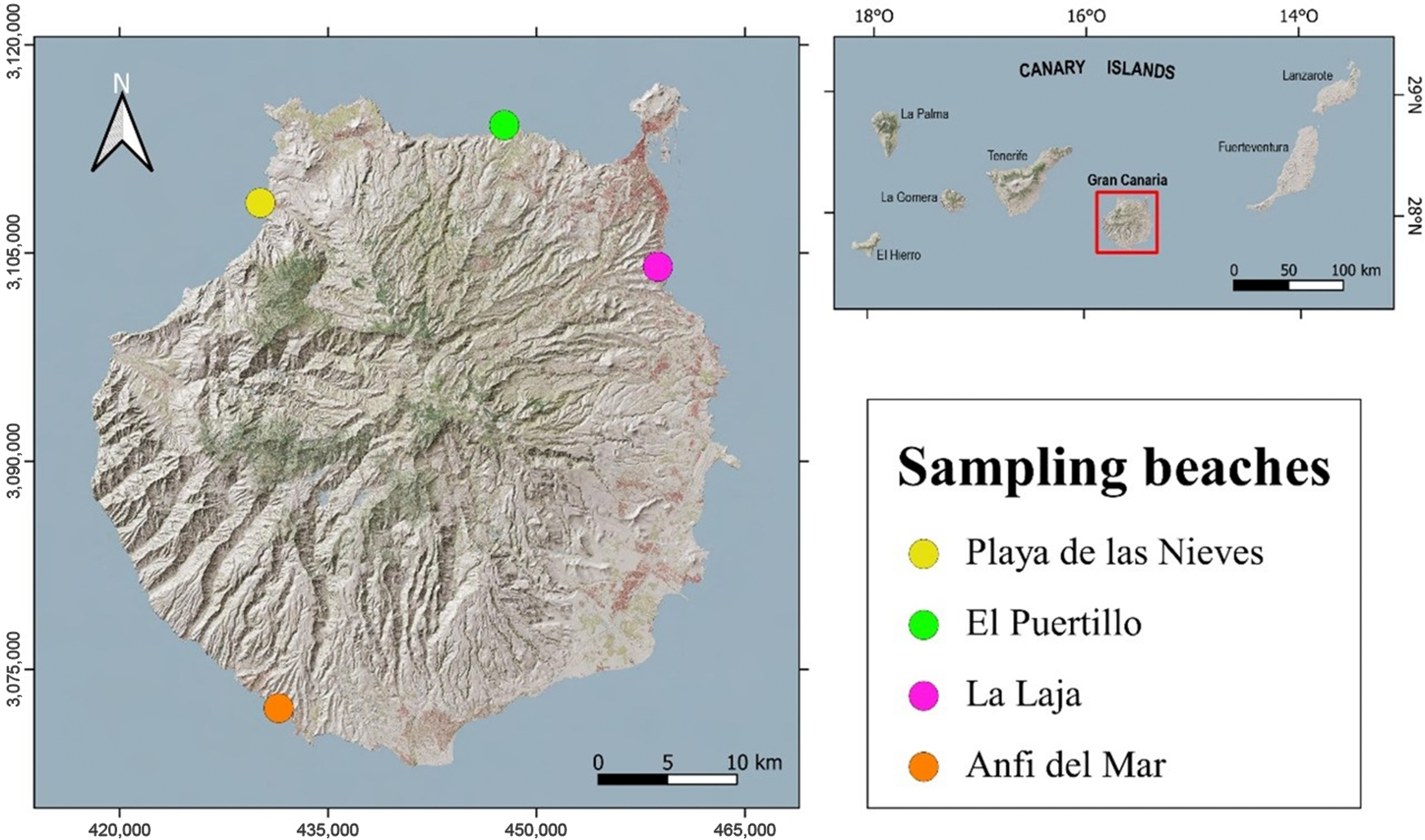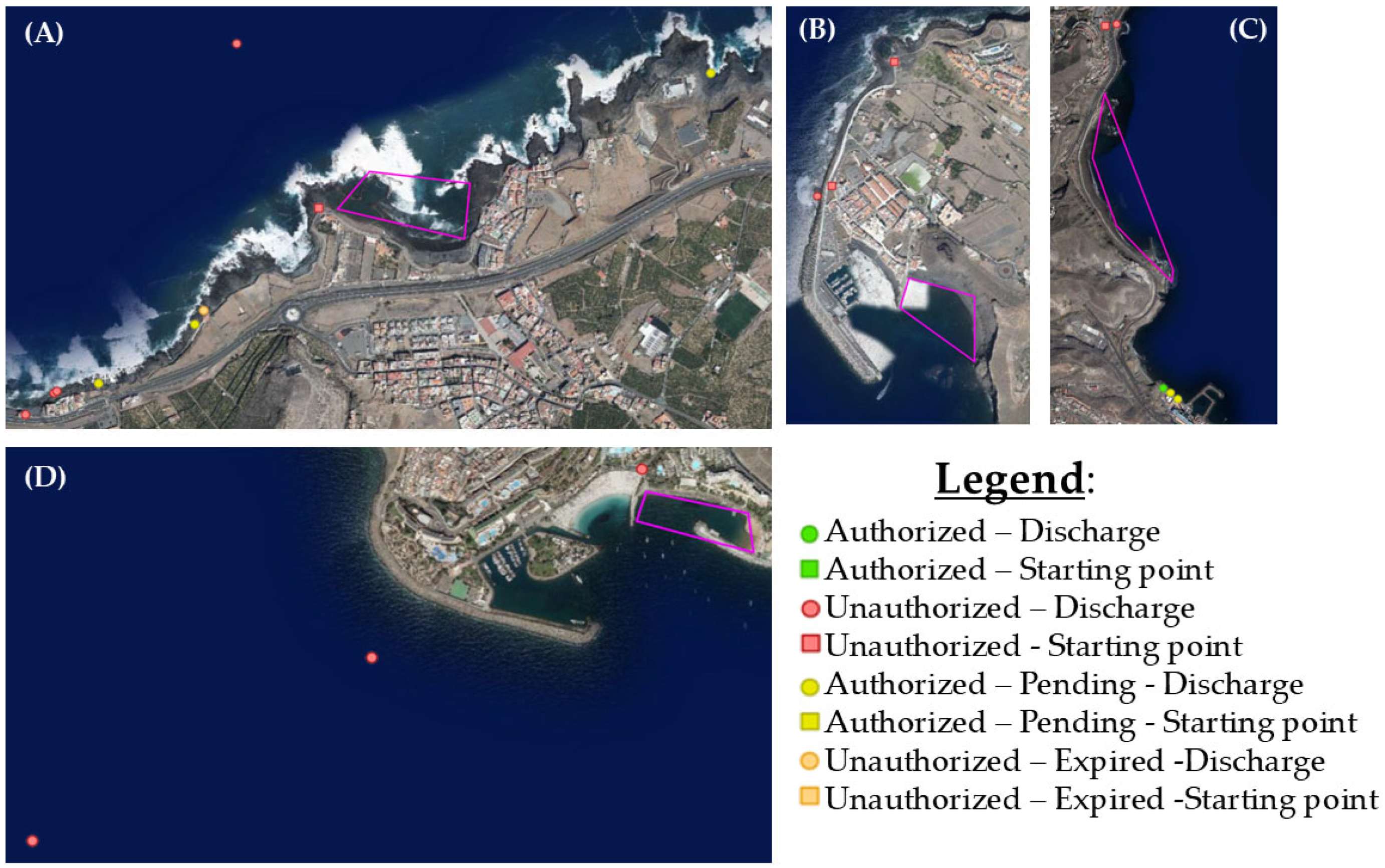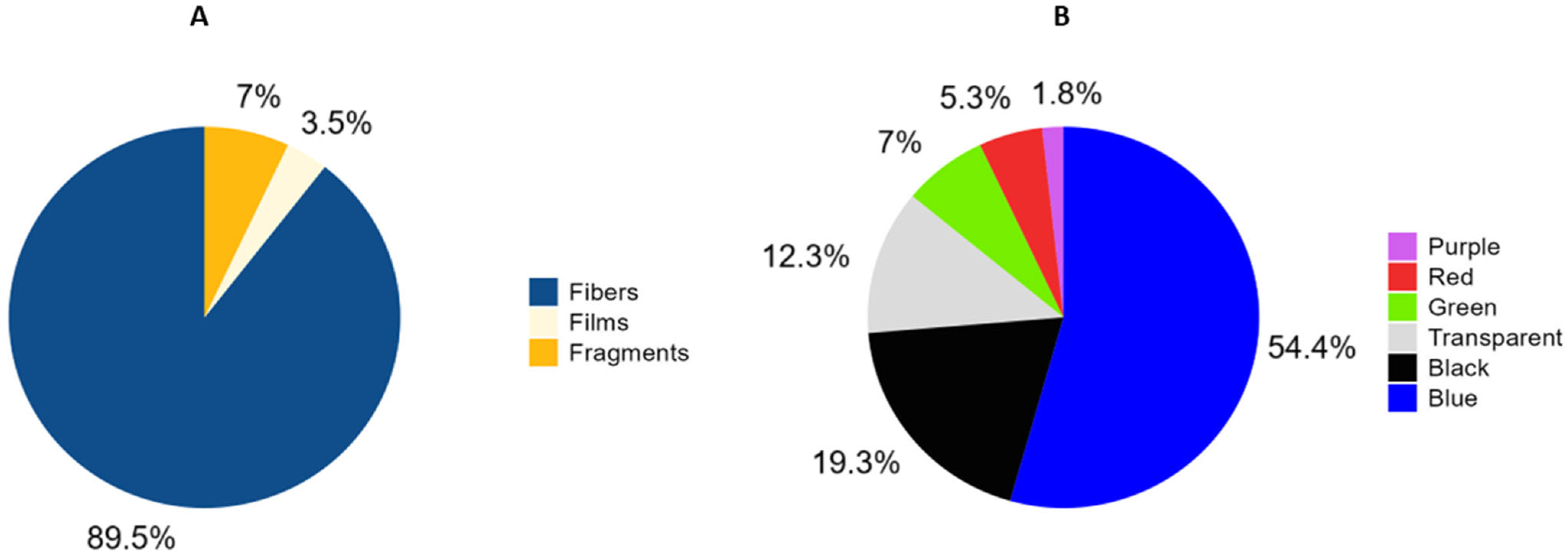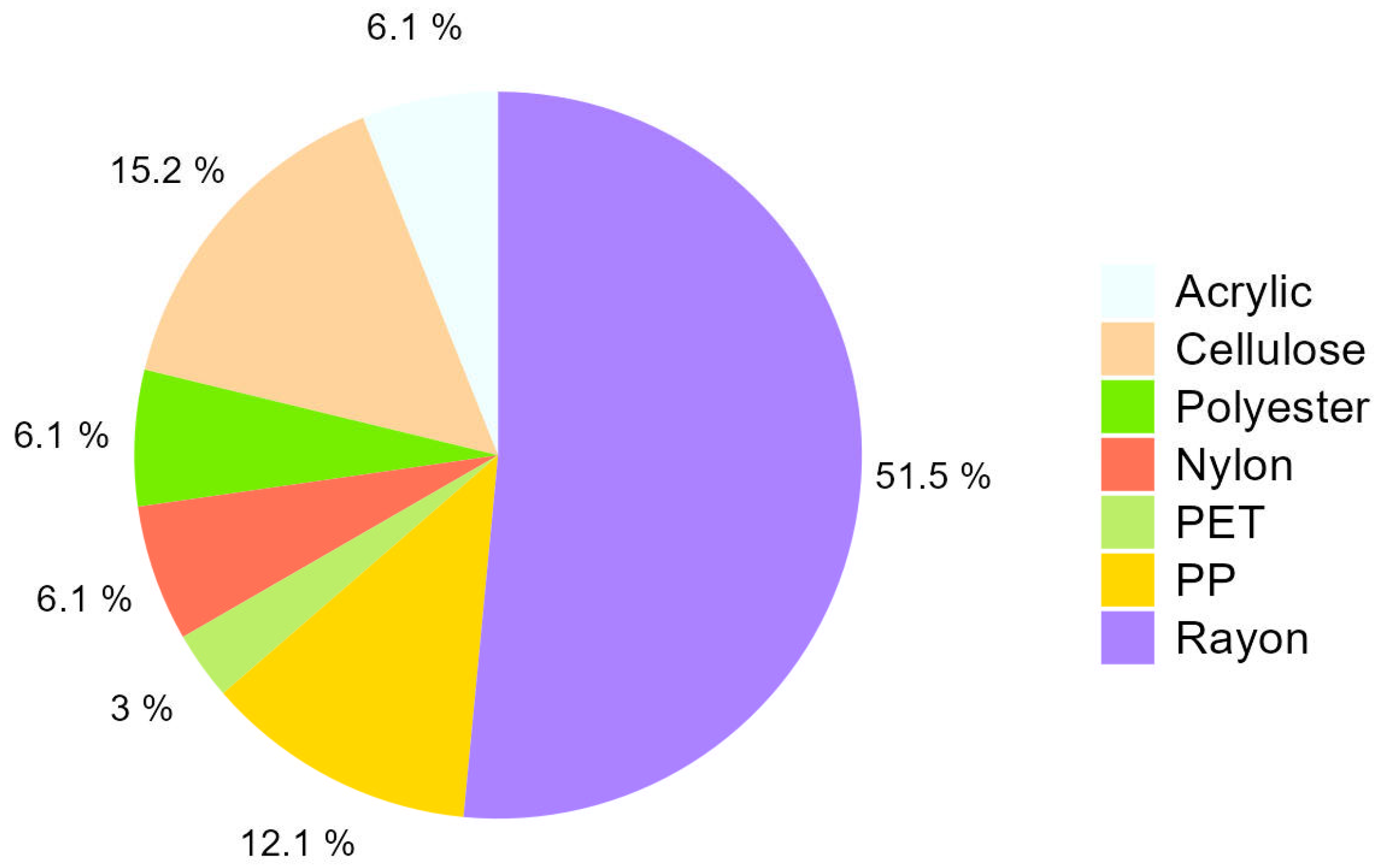Microplastics in Cronius ruber: Links to Wastewater Discharges
Simple Summary
Abstract
1. Introduction
2. Methodology
2.1. Study Area
2.2. Crab Harvesting
2.3. Laboratory Procedures
2.4. Micro-FTIR Analysis
2.5. Wastewater Discharge Point Locations
2.6. Use of Artificial Intelligence
3. Results
3.1. Frequency of Occurrence
3.2. Characteristics of Microplastics
4. Discussion
5. Conclusions
Author Contributions
Funding
Institutional Review Board Statement
Informed Consent Statement
Data Availability Statement
Acknowledgments
Conflicts of Interest
Correction Statement
References
- Thushari, G.G.N.; Senevirathna, J.D.M. Plastic Pollution in the Marine Environment. Heliyon 2020, 6, e04709. [Google Scholar] [CrossRef] [PubMed]
- Beiras, R.; Verdejo, E.; Campoy-López, P.; Vidal-Liñán, L. Aquatic Toxicity of Chemically Defined Microplastics Can Be Explained by Functional Additives. J. Hazard. Mater. 2021, 406, 124338. [Google Scholar] [CrossRef] [PubMed]
- Rochman, C.M.; Hoh, E.; Kurobe, T.; Teh, S.J. Ingested Plastic Transfers Hazardous Chemicals to Fish and Induces Hepatic Stress. Sci. Rep. 2013, 3, 3263. [Google Scholar] [CrossRef] [PubMed]
- Wright, S.L.; Thompson, R.C.; Galloway, T.S. The Physical Impacts of Microplastics on Marine Organisms: A Review. Environ. Pollut. 2013, 178, 483–492. [Google Scholar] [CrossRef]
- Setälä, O.; Fleming-Lehtinen, V.; Lehtiniemi, M. Ingestion and Transfer of Microplastics in the Planktonic Food Web. Environ. Pollut. 2014, 185, 77–83. [Google Scholar] [CrossRef]
- Napper, I.E.; Thompson, R.C. Release of Synthetic Microplastic Plastic Fibres from Domestic Washing Machines: Effects of Fabric Type and Washing Conditions. Mar. Pollut. Bull. 2016, 112, 39–45. [Google Scholar] [CrossRef]
- Stanton, T.; Stanes, E.; Gwinnett, C.; Lei, X.; Cauilan-Cureg, M.; Ramos, M.; Sallach, J.B.; Harrison, E.; Osborne, A.; Sanders, C.H.; et al. Shedding Off-the-Grid: The Role of Garment Manufacturing and Textile Care in Global Microfibre Pollution. J. Clean. Prod. 2023, 428, 139391. [Google Scholar] [CrossRef]
- Wang, C.; Song, J.; Nunes, L.M.; Zhao, H.; Wang, P.; Liang, Z.; Arp, H.P.H.; Li, G.; Xing, B. Global Microplastic Fiber Pollution from Domestic Laundry. J. Hazard. Mater. 2024, 477, 135290. [Google Scholar] [CrossRef]
- Rapp, J.; Herrera, A.; Martinez, I.; Raymond, E.; Santana, Á.; Gómez, M. Study of Plastic Pollution and Its Potential Sources on Gran Canaria Island Beaches (Canary Islands, Spain). Mar. Pollut. Bull. 2020, 153, 110967. [Google Scholar] [CrossRef]
- Herrera, A.; Asensio, M.; Martínez, I.; Santana, A.; Packard, T.; Gómez, M. Microplastic and Tar Pollution on Three Canary Islands Beaches: An Annual Study. Mar. Pollut. Bull. 2018, 129, 494–502. [Google Scholar] [CrossRef]
- Camacho, M.; Herrera, A.; Gómez, M.; Acosta-Dacal, A.; Martínez, I.; Henríquez-Hernández, L.A.; Luzardo, O.P. Organic Pollutants in Marine Plastic Debris from Canary Islands Beaches. Sci. Total Environ. 2019, 662, 22–31. [Google Scholar] [CrossRef] [PubMed]
- Reinold, S.; Herrera, A.; Stile, N.; Saliu, F.; Hernández-González, C.; Martinez, I.; Ortega, Z.; Marrero, M.D.; Lasagni, M.; Gómez, M. An Annual Study on Plastic Accumulation in Surface Water and Sediment Cores from the Coastline of Tenerife (Canary Island, Spain). Mar. Pollut. Bull. 2021, 173, 113072. [Google Scholar] [CrossRef] [PubMed]
- Reinold, S.; Herrera, A.; Saliu, F.; Hernández-González, C.; Martinez, I.; Lasagni, M.; Gómez, M. Evidence of Microplastic Ingestion by Cultured European Sea Bass (Dicentrarchus labrax). Mar. Pollut. Bull. 2021, 168, 112450. [Google Scholar] [CrossRef] [PubMed]
- Herrera, A.; Ŝtindlová, A.; Martínez, I.; Rapp, J.; Romero-Kutzner, V.; Montoto, T.; Aguiar-González, B.; Packard, T.; Gómez, M. Microplastic Ingestion by Atlantic Chub Mackerel (Scomber colias) in the Canary Islands Coast. Mar. Pollut. Bull. 2019, 139, 127–135. [Google Scholar] [CrossRef]
- Navarro, A.; Luzardo, O.P.; Gómez, M.; Acosta-Dacal, A.; Martínez, I.; Felipe de la Rosa, J.; Macías-Montes, A.; Suárez-Pérez, A.; Herrera, A. Microplastics Ingestion and Chemical Pollutants in Seabirds of Gran Canaria (Canary Islands, Spain). Mar. Pollut. Bull. 2023, 186, 114434. [Google Scholar] [CrossRef]
- Rapp, J.; Herrera, A.; Bondyale-Juez, D.R.; González-Pleiter, M.; Reinold, S.; Asensio, M.; Martínez, I.; Gómez, M. Microplastic Ingestion in Jellyfish Pelagia noctiluca (Forsskal, 1775) in the North Atlantic Ocean. Mar. Pollut. Bull. 2021, 166, 112266. [Google Scholar] [CrossRef]
- Piarulli, S.; Scapinello, S.; Comandini, P.; Magnusson, K.; Granberg, M.; Wong, J.X.W.; Sciutto, G.; Prati, S.; Mazzeo, R.; Booth, A.M.; et al. Microplastic in Wild Populations of the Omnivorous Crab Carcinus aestuarii: A Review and a Regional-Scale Test of Extraction Methods, Including Microfibres. Environ. Pollut. 2019, 251, 117–127. [Google Scholar] [CrossRef]
- Andrade, C.; Ovando, F. First Record of Microplastics in Stomach Content of the Southern King Crab Lithodes santolla (Anomura: Lithodidadae), Nassau Bay, Cape Horn, Chile. An. Inst. Patagonia 2017, 45, 59–65. [Google Scholar] [CrossRef]
- Watts, A.J.R.; Urbina, M.A.; Goodhead, R.; Moger, J.; Lewis, C.; Galloway, T.S. Effect of Microplastic on the Gills of the Shore Crab Carcinus maenas. Environ. Sci. Technol. 2016, 50, 5364–5369. [Google Scholar] [CrossRef]
- Villagran, D.M.; Truchet, D.M.; Buzzi, N.S.; Forero Lopez, A.D.; Fernández Severini, M.D. A Baseline Study of Microplastics in the Burrowing Crab (Neohelice granulata) from a Temperate Southwestern Atlantic Estuary. Mar. Pollut. Bull. 2020, 150, 110686. [Google Scholar] [CrossRef]
- Brennecke, D.; Ferreira, E.C.; Costa, T.M.M.; Appel, D.; da Gama, B.A.P.; Lenz, M. Ingested Microplastics (>100 Μm) Are Translocated to Organs of the Tropical Fiddler Crab Uca Rapax. Mar. Pollut. Bull. 2015, 96, 491–495. [Google Scholar] [CrossRef] [PubMed]
- Waite, H.R.; Donnelly, M.J.; Walters, L.J. Quantity and Types of Microplastics in the Organic Tissues of the Eastern Oyster Crassostrea virginica and Atlantic Mud Crab Panopeus herbstii from a Florida Estuary. Mar. Pollut. Bull. 2018, 129, 179–185. [Google Scholar] [CrossRef] [PubMed]
- Horn, D.A.; Granek, E.F.; Steele, C.L. Effects of Environmentally Relevant Concentrations of Microplastic Fibers on Pacific Mole Crab (Emerita analoga) Mortality and Reproduction. Limnol. Oceanogr. Lett. 2020, 5, 74–83. [Google Scholar] [CrossRef]
- González, J.A.; Triay-Portella, R.; Escribano, A.; Cuesta, J.A. Northernmost Record of the Pantropical Portunid Crab Cronius ruber in the Eastern Atlantic (Canary Islands): Natural Range Extension or Human-Mediated Introduction? Sci. Mar. 2017, 81, 81–89. [Google Scholar] [CrossRef]
- Triay-Portella, R.; Martín, J.A.; Luque, L.; Pajuelo, J.G. Relevance of Feeding Ecology in the Management of Invasive Species: Prey Variability in a Novel Invasive Crab. Estuar. Coast. Shelf Sci. 2022, 274, 107949. [Google Scholar] [CrossRef]
- Triay-Portella, R.; Escribano, A.; Pajuelo, J.G.; Tuya, F. Perception of Faunal Circadian Rhythms Depends on Sampling Technique. Mar. Environ. Res. 2018, 134, 68–75. [Google Scholar] [CrossRef]
- Edo, C.; Fernández-Piñas, F.; Leganes, F.; Gómez, M.; Martínez, I.; Herrera, A.; Hernández-Sánchez, C.; González-Sálamo, J.; Borges, J.H.; López-Castellanos, J.; et al. A Nationwide Monitoring of Atmospheric Microplastic Deposition. Sci. Total Environ. 2023, 905, 166923. [Google Scholar] [CrossRef]
- Browne, M.A.; Crump, P.; Niven, S.J.; Teuten, E.; Tonkin, A.; Galloway, T.; Thompson, R. Accumulation of Microplastic on Shorelines Woldwide: Sources and Sinks. Environ. Sci. Technol. 2011, 45, 9175–9179. [Google Scholar] [CrossRef]
- Mendes, I.S.F.; Prates, A.; Evtuguin, D.V. Production of Rayon Fibres from Cellulosic Pulps: State of the Art and Current Developments. Carbohydr. Polym. 2021, 273, 118466. [Google Scholar] [CrossRef]
- Pan, Z.; Liu, Q.; Xu, J.; Li, W.; Lin, H. Microplastic Contamination in Seafood from Dongshan Bay in Southeastern China and Its Health Risk Implication for Human Consumption. Environ. Pollut. 2022, 303, 119163. [Google Scholar] [CrossRef]
- Esterhuizen, M.; Buchenhorst, L.; Kim, Y.J.; Pflugmacher, S. In Vivo Oxidative Stress Responses of the Freshwater Basket Clam Corbicula javanicus to Microplastic Fibres and Particles. Chemosphere 2022, 296, 134037. [Google Scholar] [CrossRef] [PubMed]
- Jong, M.-C.; Li, J.; Noor, H.M.; He, Y.; Gin, K.Y.-H. Impacts of Size-Fractionation on Toxicity of Marine Microplastics: Enhanced Integrated Biomarker Assessment in the Tropical Mussels, Perna viridis. Sci. Total Environ. 2022, 835, 155459. [Google Scholar] [CrossRef] [PubMed]
- Farrell, P.; Nelson, K. Trophic Level Transfer of Microplastic: Mytilus edulis (L.) to Carcinus maenas (L.). Environ. Pollut. 2013, 177, 1–3. [Google Scholar] [CrossRef]
- Crooks, N.; Parker, H.; Pernetta, A.P. Brain Food? Trophic Transfer and Tissue Retention of Microplastics by the Velvet Swimming Crab (Necora puber). J. Exp. Mar. Biol. Ecol. 2019, 519, 151187. [Google Scholar] [CrossRef]
- Wang, T.; Hu, M.; Xu, G.; Shi, H.; Leung, J.Y.S.; Wang, Y. Microplastic Accumulation via Trophic Transfer: Can a Predatory Crab Counter the Adverse Effects of Microplastics by Body Defence? Sci. Total Environ. 2021, 754, 142099. [Google Scholar] [CrossRef]
- Welden, N.A.; Abylkhani, B.; Howarth, L.M. The Effects of Trophic Transfer and Environmental Factors on Microplastic Uptake by Plaice, Pleuronectes plastessa, and Spider Crab, Maja squinado. Environ. Pollut. 2018, 239, 351–358. [Google Scholar] [CrossRef]
- Devriese, L.I.; van der Meulen, M.D.; Maes, T.; Bekaert, K.; Paul-Pont, I.; Frère, L.; Robbens, J.; Vethaak, A.D. Microplastic Contamination in Brown Shrimp (Crangon crangon, Linnaeus 1758) from Coastal Waters of the Southern North Sea and Channel Area. Mar. Pollut. Bull. 2015, 98, 179–187. [Google Scholar] [CrossRef]
- Boerger, C.M.; Lattin, G.L.; Moore, S.L.; Moore, C.J. Plastic Ingestion by Planktivorous Fishes in the North Pacific Central Gyre. Mar. Pollut. Bull. 2010, 60, 2275–2278. [Google Scholar] [CrossRef]
- Piyawardhana, N.; Weerathunga, V.; Chen, H.S.; Guo, L.; Huang, P.J.; Ranatunga, R.R.M.K.P.; Hung, C.C. Occurrence of Microplastics in Commercial Marine Dried Fish in Asian Countries. J. Hazard. Mater. 2022, 423, 127093. [Google Scholar] [CrossRef]
- Okamoto, K.; Nomura, M.; Horie, Y.; Okamura, H. Color Preferences and Gastrointestinal-Tract Retention Times of Microplastics by Freshwater and Marine Fishes. Environ. Pollut. 2022, 304, 119253. [Google Scholar] [CrossRef]
- Sillanpää, M.; Sainio, P. Release of Polyester and Cotton Fibers from Textiles in Machine Washings. Environ. Sci. Pollut. Res. 2017, 24, 19313–19321. [Google Scholar] [CrossRef] [PubMed]
- Ory, N.C.; Sobral, P.; Ferreira, J.L.; Thiel, M. Amberstripe Scad Decapterus Muroadsi (Carangidae) Fish Ingest Blue Microplastics Resembling Their Copepod Prey along the Coast of Rapa Nui (Easter Island) in the South Pacific Subtropical Gyre. Sci. Total Environ. 2017, 586, 430–437. [Google Scholar] [CrossRef] [PubMed]
- Ogunola, S.O.; Reis-Santos, P.; Wootton, N.; Gillanders, B.M. Microplastics in Decapod Crustaceans Sourced from Australian Seafood Markets. Mar. Pollut. Bull. 2022, 179, 113706. [Google Scholar] [CrossRef] [PubMed]





| Location | ID | Sex | WSC (gr) | Year | Month | Day | Depth | Observation |
|---|---|---|---|---|---|---|---|---|
| Playa de Las Nieves | B017 | 1 | 1.5466 | 2021 | 6 | 9 | 2–5 m | 24 h KOH |
| Playa de Las Nieves | B018 | 1 | 1.5635 | 2021 | 6 | 9 | 2–5 m | 72 h KOH |
| Playa de Las Nieves | B019 | 1 | 0.727 | 2021 | 6 | 9 | 2–5 m | 72 h KOH |
| Playa de Las Nieves | B020 | 1 | 0.3555 | 2021 | 6 | 9 | 2–5 m | 72 h KOH |
| Playa de Las Nieves | B022 | 1 | 0.9287 | 2021 | 6 | 9 | 2–5 m | 72 h KOH |
| Playa de Las Nieves | B023 | 1 | 0.3184 | 2021 | 6 | 9 | 2–5 m | 24 h KOH |
| Playa de Las Nieves | B024 | 1 | 1.4 | 2021 | 6 | 9 | 2–5 m | 24 h KOH |
| Playa de Las Nieves | B025 | 1 | 1.5889 | 2021 | 6 | 9 | 2–5 m | 72 h KOH |
| Playa de Las Nieves | B026 | 1 | 0.86 | 2021 | 6 | 9 | 2–5 m | 24 h KOH |
| Playa de Las Nieves | B027 | 2 | 1.7298 | 2021 | 6 | 9 | 2–5 m | 72 h KOH |
| Playa de Las Nieves | B028 | 2 | 1.5815 | 2021 | 6 | 9 | 2–5 m | 72 h KOH |
| Playa de Las Nieves | B029 | 2 | 0.8309 | 2021 | 6 | 9 | 2–5 m | 24 h KOH |
| Playa de Las Nieves | B030 | 2 | 1.1597 | 2021 | 6 | 9 | 2–5 m | 72 h KOH |
| Playa de Las Nieves | B031 | 2 | 0.3475 | 2021 | 6 | 9 | 2–5 m | 24 h KOH |
| Playa de Las Nieves | B032 | 2 | 0.8549 | 2021 | 6 | 9 | 2–5 m | 72 h KOH |
| Playa de Las Nieves | B033 | 2 | 2.3075 | 2021 | 6 | 9 | 2–5 m | 24 h KOH |
| Playa de Las Nieves | B034 | 2 | 0.9357 | 2021 | 6 | 9 | 2–5 m | 72 h KOH |
| Playa de Las Nieves | B035 | 2 | 0.844 | 2021 | 6 | 9 | 2–5 m | 24 h KOH |
| Playa de Las Nieves | B036 | 2 | 0.796 | 2021 | 6 | 9 | 2–5 m | 72 h KOH |
| Playa de Las Nieves | B037 | 2 | 0.52 | 2021 | 6 | 9 | 2–5 m | 24 h KOH |
| Playa de Las Nieves | B038 | 2 | 1.364 | 2021 | 6 | 9 | 2–5 m | 72 h KOH |
| Playa de Las Nieves | B039 | 2 | 1.44 | 2021 | 6 | 9 | 2–5 m | 72 h KOH |
| La Laja Beach | B040 | 1 | 1.9705 | 2021 | 6 | 15 | 2–5 m | 72 h KOH |
| La Laja Beach | B041 | 1 | 1.665 | 2021 | 6 | 15 | 2–5 m | 24 h KOH |
| La Laja Beach | B042 | 1 | 1.0377 | 2021 | 6 | 15 | 2–5 m | 72 h KOH |
| La Laja Beach | B043 | 1 | 0.6805 | 2021 | 6 | 15 | 2–5 m | 72 h KOH |
| La Laja Beach | B044 | 2 | 0.5705 | 2021 | 6 | 15 | 2–5 m | 24 h KOH |
| La Laja Beach | B045 | 2 | 0.3036 | 2021 | 6 | 15 | 2–5 m | 72 h KOH |
| Anfi del Mar Beach | B046 | 2 | 1.723 | 2021 | 5 | 1 | 2–3 m | 24 h KOH |
| Anfi del Mar Beach | B047 | 2 | 0.8472 | 2021 | 5 | 1 | 2–3 m | 24 h KOH |
| Anfi del Mar Beach | B048 | 2 | 0.5424 | 2021 | 5 | 1 | 2–3 m | 24 h KOH |
| El Puertillo Beach | B050 | 1 | 1.2897 | 2021 | 7 | 20 | 1–3 m | 72 h KOH |
| El Puertillo Beach | B051 | 1 | 1.7483 | 2021 | 7 | 20 | 1–3 m | 24 h KOH |
| El Puertillo Beach | B052 | 1 | 0.9359 | 2021 | 7 | 20 | 1–3 m | 24 h KOH |
| El Puertillo Beach | B053 | 2 | 0.7529 | 2021 | 7 | 20 | 1–3 m | 24 h KOH |
| El Puertillo Beach | B054 | 2 | 0.548 | 2021 | 7 | 20 | 1–3 m | 72 h KOH |
| El Puertillo Beach | B056 | 1 | 0.6808 | 2021 | 7 | 27 | 1–3 m | 24 h KOH |
| El Puertillo Beach | B057 | 1 | 0.6906 | 2021 | 7 | 27 | 1–3 m | 24 h KOH |
| El Puertillo Beach | B058 | 1 | 1.7035 | 2021 | 7 | 27 | 1–3 m | 24 h KOH |
| El Puertillo Beach | B059 | 1 | 1.265 | 2021 | 7 | 27 | 1–3 m | 24 h KOH |
| El Puertillo Beach | B060 | 1 | 2.2029 | 2021 | 7 | 27 | 1–3 m | 24 h KOH |
| El Puertillo Beach | B061 | 1 | 0.6934 | 2021 | 7 | 27 | 1–3 m | 24 h KOH |
| El Puertillo Beach | B062 | 1 | 0.8472 | 2021 | 7 | 27 | 1–3 m | 24 h KOH |
| El Puertillo Beach | B063 | 1 | 1.2546 | 2021 | 7 | 27 | 1–3 m | 24 h KOH |
| El Puertillo Beach | B064 | 1 | 0.4226 | 2021 | 7 | 27 | 1–3 m | 24 h KOH |
| El Puertillo Beach | B065 | 1 | 1.7793 | 2021 | 7 | 27 | 1–3 m | 24 h KOH |
| El Puertillo Beach | B071 | 2 | 1.6161 | 2021 | 7 | 27 | 1–3 m | 24 h KOH |
| El Puertillo Beach | B072 | 2 | 1.0271 | 2021 | 7 | 27 | 1–3 m | 24 h KOH |
| El Puertillo Beach | B073 | 2 | 1.31 | 2021 | 7 | 27 | 1–3 m | 24 h KOH |
| El Puertillo Beach | B074 | 2 | 0.5028 | 2021 | 7 | 27 | 1–3 m | 24 h KOH |
| El Puertillo Beach | B075 | 2 | 1.5454 | 2021 | 7 | 27 | 1–3 m | 24 h KOH |
| El Puertillo Beach | B076 | 2 | 1.4604 | 2021 | 7 | 27 | 1–3 m | 24 h KOH |
| El Puertillo Beach | B077 | 2 | 0.7471 | 2021 | 7 | 27 | 1–3 m | 72 h KOH |
| El Puertillo Beach | B078 | 2 | 1.0557 | 2021 | 7 | 27 | 1–3 m | 24 h KOH |
| El Puertillo Beach | B079 | 2 | 0.5218 | 2021 | 7 | 27 | 1–3 m | 24 h KOH |
| El Puertillo Beach | B080 | 2 | 0.756 | 2021 | 7 | 27 | 1–3 m | 24 h KOH |
| El Puertillo Beach | B081 | 2 | 0.6707 | 2021 | 7 | 27 | 1–3 m | 24 h KOH |
| El Puertillo Beach | B082 | 2 | 0.2323 | 2021 | 7 | 27 | 1–3 m | 24 h KOH |
| El Puertillo Beach | B083 | 2 | 0.4822 | 2021 | 7 | 27 | 1–3 m | 72 h KOH |
| El Puertillo Beach | B084 | 2 | 0.6083 | 2021 | 7 | 27 | 1–3 m | 24 h KOH |
| El Puertillo Beach | B085 | 2 | 1.22 | 2021 | 10 | 1 | 1–4 m | 24 h KOH |
| El Puertillo Beach | B086 | 2 | 1.2649 | 2021 | 10 | 1 | 1–4 m | 24 h KOH |
| El Puertillo Beach | B087 | 1 | - | 2021 | 10 | 1 | 1–4 m | 24 h KOH |
| El Puertillo Beach | B088 | 2 | 1.0579 | 2021 | 10 | 1 | 1–4 m | 24 h KOH |
| Location | n | Mean MP/ind | SD | FO% |
|---|---|---|---|---|
| Playa de Las Nieves | 22 | 1.56 | 0.73 | 41 |
| La Laja Beach | 6 | 3.67 | 2.08 | 50 |
| Anfi del Mar Beach | 3 | 3.00 | 1.41 | 67 |
| El Puertillo Beach | 32 | 1.37 | 0.60 | 58 |
| Total | 63 | 1.73 | 1.10 | 52 |
| Sample | Type | Polymer | Coincidence (%) |
|---|---|---|---|
| 1 | Fiber | Cellulose | 73 |
| 2 | Fiber | NI | - |
| 3 | Fragment | NI | - |
| 4 | Fiber | NI | - |
| 5 | Fiber | Cellulose | 87 |
| 6 | Fiber | NI | - |
| 7 | Fiber | Polyethylene Terephthalate | 83 |
| 8 | Fiber | Rayon | 85 |
| 9 | Fiber | Polymethyl Methacrylate | 83 |
| 10 | Fiber | Rayon | 67 |
| 11 | Fiber | Cellulose | 89 |
| 12 | Fiber | Rayon | 73 |
| 13 | Fiber | NI | - |
| 14 | Fiber | Polypropylene | 95 |
| 15 | Fiber | Rayon | 68 |
| 16 | Fiber | Rayon | 68 |
| 17 | Fiber | Rayon | 76 |
| 18 | Fiber | Rayon | 83 |
| 19 | Fiber | Polyester | 94 |
| 20 | Fiber | Rayon | 74 |
| 21 | Fragment | NI | - |
| 22 | Fiber | Polypropylene | 95 |
| 23 | Fiber | Rayon | 75 |
| 24 | Fiber | Rayon | 72 |
| 25 | Fiber | Polyester | 75 |
| 26 | Fiber | Rayon | 83 |
| 27 | Fiber | PP | 94 |
| 28 | Fiber | Rayon | 85 |
| 29 | Fiber | Nylon | 88 |
| 30 | Fragment | Polymethyl Methacrylate | 75 |
| 31 | Fiber | Nylon | 95 |
| 32 | Fiber | Rayon | 57 |
| 33 | Fiber | Rayon | 87 |
| 34 | Fiber | Cellulose | 70 |
| 35 | Fiber | NI | - |
| 36 | Fiber | Rayon | 71 |
| 37 | Fiber | Rayon | 69 |
| 38 | Fiber | Rayon | 79 |
| 39 | Fiber | Polypropylene | 91 |
| 40 | Fiber | Cellulose | 82 |
Disclaimer/Publisher’s Note: The statements, opinions and data contained in all publications are solely those of the individual author(s) and contributor(s) and not of MDPI and/or the editor(s). MDPI and/or the editor(s) disclaim responsibility for any injury to people or property resulting from any ideas, methods, instructions or products referred to in the content. |
© 2025 by the authors. Licensee MDPI, Basel, Switzerland. This article is an open access article distributed under the terms and conditions of the Creative Commons Attribution (CC BY) license (https://creativecommons.org/licenses/by/4.0/).
Share and Cite
Huelbes, S.; Gómez, M.; Martínez, I.; Triay-Portella, R.; González-Pleiter, M.; Herrera, A. Microplastics in Cronius ruber: Links to Wastewater Discharges. Animals 2025, 15, 1420. https://doi.org/10.3390/ani15101420
Huelbes S, Gómez M, Martínez I, Triay-Portella R, González-Pleiter M, Herrera A. Microplastics in Cronius ruber: Links to Wastewater Discharges. Animals. 2025; 15(10):1420. https://doi.org/10.3390/ani15101420
Chicago/Turabian StyleHuelbes, Sofía, May Gómez, Ico Martínez, Raül Triay-Portella, Miguel González-Pleiter, and Alicia Herrera. 2025. "Microplastics in Cronius ruber: Links to Wastewater Discharges" Animals 15, no. 10: 1420. https://doi.org/10.3390/ani15101420
APA StyleHuelbes, S., Gómez, M., Martínez, I., Triay-Portella, R., González-Pleiter, M., & Herrera, A. (2025). Microplastics in Cronius ruber: Links to Wastewater Discharges. Animals, 15(10), 1420. https://doi.org/10.3390/ani15101420







